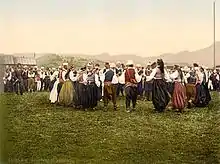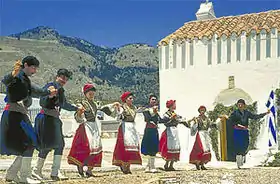Kolo (dance)
In Southeastern Europe, the South Slavic people traditionally dance the circle dance, known as kolo (Cyrillic: коло), named after the circle formed by the dancers.


It is known as horo (Bulgarian: хоро) in Bulgaria and oro (Macedonian: оро) in North Macedonia and Montenegro.[1]
Description
The circle dance is usually performed amongst groups of at least three people and up to several dozen people. Dancers hold each other's hands or each other's waists. They form a circle, a single chain or multiple parallel lines.[2]
Kolo requires almost no movement above the waist. The basic steps are easy to learn. Experienced dancers demonstrate virtuosity by adding different ornamental elements, such as syncopated steps. Each region has at least one unique kolo.[2] It is difficult to master the dance and even most experienced dancers cannot master all of them.
Kolo is performed at weddings, social, cultural, and religious ceremonies.[1] Some dances require both men and women to dance together, others require only the men or only the women.
Music
The music is generally fast-paced.[1] The dance was used by Antonín Dvořák in his Slavonic Dances – the Serbian kolo is the seventh dance from opus 72.[3]
Traditional dance costume
Traditional dance costumes vary from region to region. Bordering regions are mostly more similar to each other.[4]
Bosnia, Croatia and Serbia
Various kolos are performed at social ceremonies. Often traditional clothing, which is unique to a region, is worn. The most common kolo is the "narodno kolo" or "drmeš"; a standard step followed by accordeon music.
See also
| Wikimedia Commons has media related to Kolo (dance). |
- Armenian dance
- Assyrian folk dance
- Circle dance
- Croatian dances
- Dabke
- Faroese dance
- Greek dances
- Hora (dance)
- Khorovod, an Eastern European circle dance
- Kurdish dance
- Serbian dances
- Turkish dance
References
- "kolo" (2009). Encyclopædia Britannica. Retrieved March 26, 2009.
- "UNESCO - Kolo, traditional folk dance". ich.unesco.org. Retrieved 2020-10-03.
- "Slavonic Dance, Op. 72, No. 7 (Antonín Dvořák)". LA Phil. Retrieved 2020-10-03.
- "Ethnic Heritage - National Cotumes". www.serbia.com. Retrieved 2020-10-03.
External links
- Music and video of the basic Kolo
- Bosnian Folk Dance : The Kolo
- Kolo, traditional folk dance on the Unesco YouTube channel
